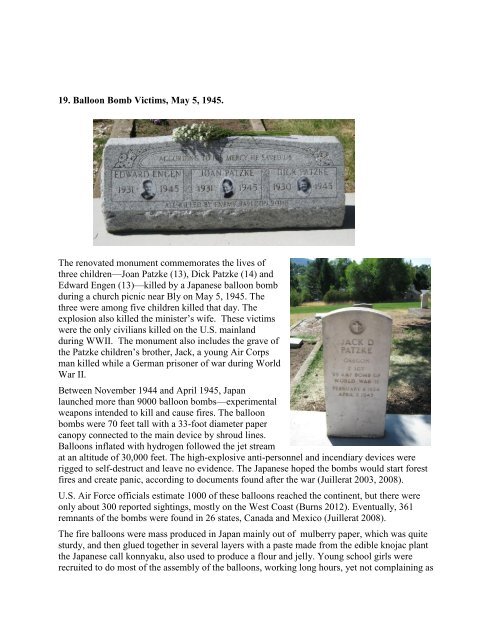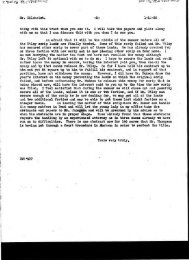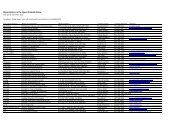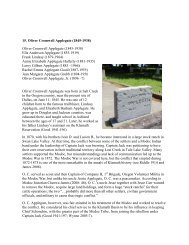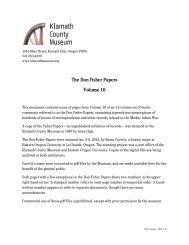19. Balloon Bomb Victims, May 5, 1945. The renovated monument ...
19. Balloon Bomb Victims, May 5, 1945. The renovated monument ...
19. Balloon Bomb Victims, May 5, 1945. The renovated monument ...
Create successful ePaper yourself
Turn your PDF publications into a flip-book with our unique Google optimized e-Paper software.
<strong>19.</strong> <strong>Balloon</strong> <strong>Bomb</strong> <strong>Victims</strong>, <strong>May</strong> 5, <strong>1945.</strong><br />
<strong>The</strong> <strong>renovated</strong> <strong>monument</strong> commemorates the lives of<br />
three children—Joan Patzke (13), Dick Patzke (14) and<br />
Edward Engen (13)—killed by a Japanese balloon bomb<br />
during a church picnic near Bly on <strong>May</strong> 5, <strong>1945.</strong> <strong>The</strong><br />
three were among five children killed that day. <strong>The</strong><br />
explosion also killed the minister’s wife. <strong>The</strong>se victims<br />
were the only civilians killed on the U.S. mainland<br />
during WWII. <strong>The</strong> <strong>monument</strong> also includes the grave of<br />
the Patzke children’s brother, Jack, a young Air Corps<br />
man killed while a German prisoner of war during World<br />
War II.<br />
Between November 1944 and April 1945, Japan<br />
launched more than 9000 balloon bombs—experimental<br />
weapons intended to kill and cause fires. <strong>The</strong> balloon<br />
bombs were 70 feet tall with a 33-foot diameter paper<br />
canopy connected to the main device by shroud lines.<br />
<strong>Balloon</strong>s inflated with hydrogen followed the jet stream<br />
at an altitude of 30,000 feet. <strong>The</strong> high-explosive anti-personnel and incendiary devices were<br />
rigged to self-destruct and leave no evidence. <strong>The</strong> Japanese hoped the bombs would start forest<br />
fires and create panic, according to documents found after the war (Juillerat 2003, 2008).<br />
U.S. Air Force officials estimate 1000 of these balloons reached the continent, but there were<br />
only about 300 reported sightings, mostly on the West Coast (Burns 2012). Eventually, 361<br />
remnants of the bombs were found in 26 states, Canada and Mexico (Juillerat 2008).<br />
<strong>The</strong> fire balloons were mass produced in Japan mainly out of mulberry paper, which was quite<br />
sturdy, and then glued together in several layers with a paste made from the edible knojac plant<br />
the Japanese call konnyaku, also used to produce a flour and jelly. Young school girls were<br />
recruited to do most of the assembly of the balloons, working long hours, yet not complaining as
everything in their country’s war effort was for Emperor Hirohito and the glory of Japan, who<br />
they perceived, would never lose the war (Burns 2012, Sol 2008).<br />
<strong>The</strong> configuration of the balloons included up to four or five incendiary bombs and one highexplosive<br />
bomb. <strong>The</strong> balloons relied on an intricate ballast system as it would rise and lower<br />
over the Jet Stream with the use of bags of sand that would drop off in set intervals until the last<br />
bag dropped, lowering the balloon to its eventual landing and intended detonation of its<br />
destructive payload (Burns 2012; Webber 1988).<br />
<strong>The</strong> first bomb was spotted southwest of San Pedro, California, on November 4, 1944. On<br />
January 4, 1945, two men working near Medford, Oregon, heard a blast, saw flames, and found a<br />
twelve-inch-deep hole in the ground where the bomb had exploded. <strong>The</strong> U.S. Office of<br />
Censorship asked the news media not to publish reports for fear it might cause panic (Burns<br />
2012, Juillerat 2008).<br />
On Saturday morning, <strong>May</strong> 5, 1945, Archie Mitchell, the pastor of the Christian and Missionary<br />
Alliance Church in Bly, Oregon, drove his wife Elsye and five children who attended his Sunday<br />
school on a fishing trip near Gearhart Mountain. Elyse, five months pregnant and feeling carsick,<br />
got out with the children to walk down to Leonard Creek while Archie parked up the road (Most<br />
2003). Mitchell later remembered: "As I got out of the car to bring the lunch, the others were not<br />
far away and called to me they had found something that looked like a balloon. I heard of<br />
Japanese balloons so I shouted a warning not to touch it. But just then there was a big explosion.<br />
I ran up there—and they were all dead" (Juillerat 2008).<br />
A stone <strong>monument</strong> to the victims was placed at the site of the explosion near Bly, Oregon<br />
(Donnelly 2002; Most 2003). When the stone <strong>monument</strong> was dedicated on August 20, 1950,<br />
Oregon Governor Douglas McKay said the members of the Mitchell family were casualties "just<br />
as surely as if they had been in uniform" (Juillerat 2008). <strong>The</strong>se victims were the only civilians<br />
killed on the U.S. mainland during WWII. <strong>The</strong> site was designated on the National Register of<br />
Historic Places in 2003.<br />
Two years after the balloon bomb incident in Bly, Oregon, Pastor Archie Mitchell married Betty<br />
Patzke, the older sister of victims Dick and Joan Patzke, who perished in the incident. Archie and<br />
Betty had four children. In 1962 Archie was performing missionary work in Vietnam and was<br />
captured with other workers by the Vietcong and was never seen again (Burns 2012; Annie and<br />
Maxine Patzke, Personal Communications, 2010).<br />
Jack Patzke (February 8, 1924 – April 8, 1945)<br />
<strong>The</strong> <strong>monument</strong> also includes the grave of Jack Patzke, older brother of the Patzke children who<br />
was killed on April 8, 1945, a few weeks before the children. He was serving with the 99 th<br />
<strong>Bomb</strong>er Group, 347 th <strong>Bomb</strong> Squadron, when his plane was shot down on April 30, 1944, near<br />
Bologna, Italy. He was taken by the Germans as a prisoner of war and detained at Stalag Luft III<br />
Sagan-Silesia, Bavaria. In the winter of 1945, along with 10,000 other prisoners, he was forced<br />
on a 200-mile march to Nuremberg. He was killed while trying to escape during the march; his<br />
death was reported on April 8, 1945 (KCM n.d.). Jack’s body was shipped home in 1950 and he<br />
was buried at Linkville Cemetery (Annie and Maxine Patzke, Personal Communication, 2010).
Cemetery Monument Restoration<br />
In 2010, the Klamath Falls City Parks and Cemetery Division totally restored the <strong>monument</strong>,<br />
which was funded in part by a grant from the Oregon Commission on Historic Cemeteries (Hay<br />
and Budy 2010). <strong>The</strong> original concrete cover was broken and collapsed by shrubs edging the<br />
<strong>monument</strong>. <strong>The</strong> children’s photo plaques had been defaced by vandals. City Parks’ staff removed<br />
the shrubs; contractors replaced the concrete cover and reset the <strong>monument</strong>s. Maxine and Annie<br />
Patzke provided family information and guidance throughout the restoration as well as<br />
replacement photos for the children’s marker. Finally, a special dedication of the restored<br />
<strong>monument</strong> was held on September 11, 2010 (Herald and News February 17, September 9, and<br />
September 19, 2010).<br />
Sources<br />
Burns, Bridget. (2012). “Fu-Go: Fire from the Sky.” Paper presented at the State of Jefferson<br />
Meetings in Klamath Falls, Oregon, <strong>May</strong> 3, 2012.<br />
Donnelly, Robert. (2002). “War Memorial, Lake County.” <strong>The</strong> Oregon History Project: Oregon<br />
Historical Society. Available online at www.ohs.org/.<br />
Hay, Ken, and Elizabeth Budy. 2010. Final Project Report for the Historic Cemetery Grant. CG-<br />
09-12. Submitted to the Oregon Commission on Historic Cemeteries, Salem, Oregon.<br />
Juillerat, Lee. (2003). "Mitchell Monument: A Place Remembered." Service & Sacrifice:<br />
Klamath Basin Life Through Two World Wars. Journal of the Shaw Historical Library,<br />
Vol. 17.<br />
Juillerat, Lee. (2008). “<strong>Balloon</strong> <strong>Bomb</strong>s.” <strong>The</strong> Oregon Encyclopedia. Available online at<br />
http://www.oregonencyclopedia.org/entry/view/balloon_bombs/<br />
Klamath County Museum (KCM). (n.d.). “Killed in Action and Missing in Action Files. On file<br />
Klamath County Museum, Klamath Falls, Oregon.<br />
Most, Stephen. (2003). “Death by <strong>Balloon</strong> <strong>Bomb</strong>.” <strong>The</strong> Oregon History Project: Oregon Historical Society.<br />
Available online at www.ohs.org/.<br />
Sol, Ilana. (2008). On Paper Wings. Film. Portland, Ore.: Ilana Sol, 2008.<br />
http://www.onpaperwingsthemovie.com/index.html.<br />
Webber, Bert. (1988). Silent Siege-II: Japanese Attacks on North America in World War II.<br />
Webb Research Group. Medford, Oregon.<br />
Newspapers<br />
"Blast Kills 6, Five Children, Pastor's Wife in Explosion: Fishing Jaunt Proves Fatal to Bly<br />
Residents," Klamath Falls Herald and News, 7 <strong>May</strong> 1945, page 1.<br />
“Grave Issues at Linkville Cemetery,” Herald and News, Wednesday, February 17, 2010.<br />
“Restoring History at the Linkville Cemetery: Volunteers, City, Grants Help Fix Historic<br />
Klamath Falls Graveyard,” Herald and News, Thursday, September 9, 2010.<br />
“Monument Dedicated at Linkville Cemetery,” Herald and News, Sunday, September 19, 2010.<br />
Personal Communications<br />
Annie and Maxine Patzke, Personal Communications, 2010.
Compiled by Bridget Burns and Elizabeth Budy 2013


